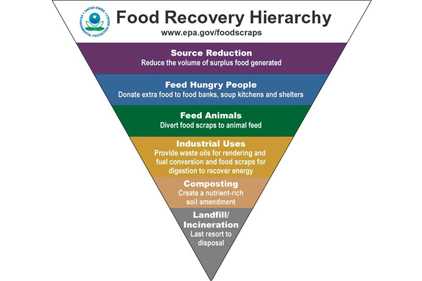A new study from the Food Waste Reduction Alliance (FWRA) seeks to benchmark food waste in the US manufacturing, retail and wholesale sectors based on primary data collected directly from companies. The results show that while the manufacturing sector created more waste, it is also able to divert a larger proportion of it from landfills than is the case in the retail and wholesale sectors.
FWRA grades food waste based on the US EPA’s food waste recovery hierarchy, an upside-down pyramid showing proper prioritization of food waste disposal options. Most preferable, of course, is source reduction—that is, reduce the volume of food waste generated.
The next option is to feed hungry people by donating to food banks, soup kitchens and shelters. Next, EPA recommends diverting human food scraps to animal feed. The fourth option is to find an industrial use for the food waste, such as waste oils for fuel. If the food waste cannot be diverted through one of these methods, EPA recommends composting and, as a last resort, landfill or incineration.
FWRA found that while the manufacturing sector generated 44.3 billion pounds of food waste in 2011 compared to retail and wholesale’s 3.8 billion pounds, 94.6 percent of food waste from manufacturing was diverted to higher-priority uses than landfill, compared to only 55.6 percent in retail and wholesale.
However, while the manufacturing sector and retail and wholesale sectors generated significantly different amounts of food waste, they donated and disposed of similar amounts in 2011. Manufacturing disposed of 2.4 billion pounds compared to 1.7 billion pounds for retail and wholesale, and manufacturing donated 700 million pounds compared to retail and wholesale’s 670 million.
Overall, 4.1 billion pounds of food waste were disposed of via landfill or incinerator in 2011, representing only 8.5 percent of the 48.1 billion pounds of food waste generated annually in North America. Seventy-three percent of the diverted food waste from manufacturing went to animal feed, while food donation and composting were the primary diversion methods of the retail and wholesale sectors.
FWRA says the survey results point to room for further improvement—for food manufacturers, the opportunity to reduce the total amount of food waste created while moving up the food waste hierarchy to increase the percentage that is donated. Retailers and wholesalers can divert more waste from landfills to higher uses while continuing to focus on reducing food waste.
Barriers to more donation of food waste include logistical transportation and liability concerns, while an insufficient number of options was the most frequently cited obstacle to recycling and composting.



